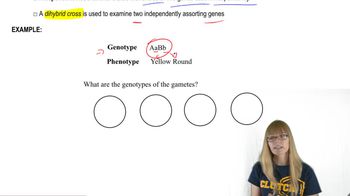Table of contents
- 1. Introduction to Genetics51m
- 2. Mendel's Laws of Inheritance3h 37m
- 3. Extensions to Mendelian Inheritance2h 41m
- 4. Genetic Mapping and Linkage2h 28m
- 5. Genetics of Bacteria and Viruses1h 21m
- 6. Chromosomal Variation1h 48m
- 7. DNA and Chromosome Structure56m
- 8. DNA Replication1h 10m
- 9. Mitosis and Meiosis1h 34m
- 10. Transcription1h 0m
- 11. Translation58m
- 12. Gene Regulation in Prokaryotes1h 19m
- 13. Gene Regulation in Eukaryotes44m
- 14. Genetic Control of Development44m
- 15. Genomes and Genomics1h 50m
- 16. Transposable Elements47m
- 17. Mutation, Repair, and Recombination1h 6m
- 18. Molecular Genetic Tools19m
- 19. Cancer Genetics29m
- 20. Quantitative Genetics1h 26m
- 21. Population Genetics50m
- 22. Evolutionary Genetics29m
2. Mendel's Laws of Inheritance
Probability and Genetics
Problem 41g
Textbook Question
Humans vary in many ways from one another. Among many minor phenotypic differences are the following five independently assorting traits that (sort of) have a dominant and a recessive phenotype: (1) forearm hair (alleles F and f )—the presence of hair on the forearm is dominant to the absence of hair on the forearm; (2) earlobe form (alleles E and e)—unattached earlobes are dominant to attached earlobes; (3) widow's peak (alleles W and w)—a distinct 'V' shape to the hairline at the top of the forehead is dominant to a straight hairline; (4) hitchhiker's thumb (alleles H and h)—the ability to bend the thumb back beyond vertical is dominant and the inability to do so is recessive; and (5) freckling (alleles D and d)—the appearance of freckles is dominant to the absence of freckles. In reality, the genetics of these traits are more complicated than single gene variation, but assume for the purposes of this problem that the patterns in families match those of other single-gene variants.
If a couple with the genotypes Ff Ee Ww Hh Dd and Ff Ee Ww Hh Dd have children, what is the chance the children will inherit the following characteristics?
the genotype Ff EE Ww hh dd
 Verified step by step guidance
Verified step by step guidance1
Identify the genotypes of the parents: both are Ff Ee Ww Hh Dd.
Determine the probability of each trait being inherited by the child independently, as the traits assort independently.
For the genotype Ff: Calculate the probability of inheriting one F allele and one f allele from the parents.
For the genotype EE: Calculate the probability of inheriting two E alleles from the parents.
For the genotype Ww hh dd: Calculate the probability of inheriting one W allele and one w allele, two h alleles, and two d alleles from the parents.
Recommended similar problem, with video answer:
 Verified Solution
Verified SolutionThis video solution was recommended by our tutors as helpful for the problem above
Video duration:
1mPlay a video:
Was this helpful?
Key Concepts
Here are the essential concepts you must grasp in order to answer the question correctly.
Mendelian Genetics
Mendelian genetics is the study of how traits are inherited through generations based on the principles established by Gregor Mendel. It involves understanding dominant and recessive alleles, where dominant traits mask the expression of recessive traits. This framework helps predict the probability of offspring inheriting specific traits based on parental genotypes.
Recommended video:
Guided course

Descriptive Genetics
Punnett Square
A Punnett square is a diagram used to predict the genetic makeup of offspring from two parents. By organizing the possible gametes from each parent, it allows for the visualization of potential genotype combinations. This tool is essential for calculating the probabilities of specific traits appearing in the offspring, such as the genotype Ff EE Ww hh dd in this scenario.
Recommended video:
Guided course

Chi Square Analysis
Independent Assortment
Independent assortment is a principle stating that alleles for different traits segregate independently of one another during gamete formation. This means that the inheritance of one trait does not influence the inheritance of another, allowing for a variety of genetic combinations. Understanding this concept is crucial for analyzing the inheritance patterns of multiple traits simultaneously, as seen in the question.
Recommended video:
Guided course

Gamete Genetics and Independent Assortment
Related Videos
Related Practice




